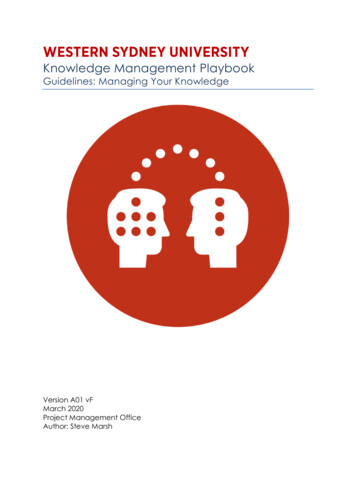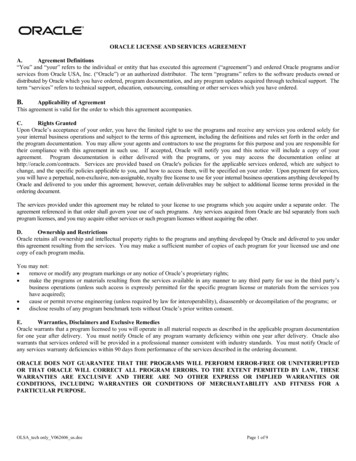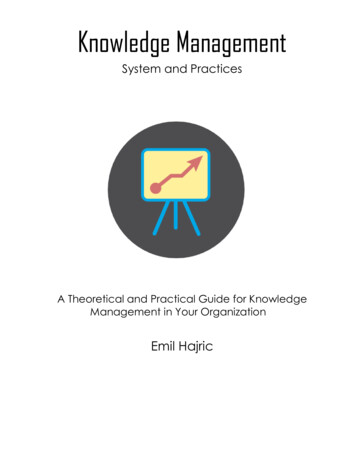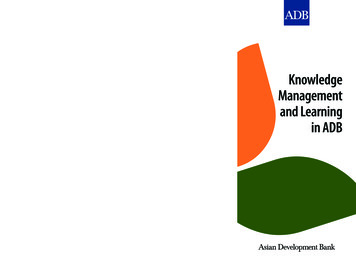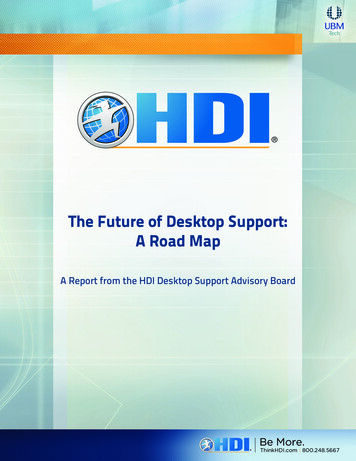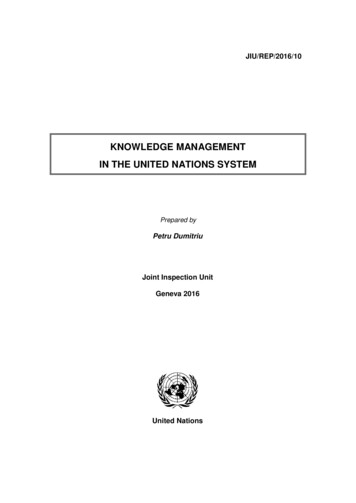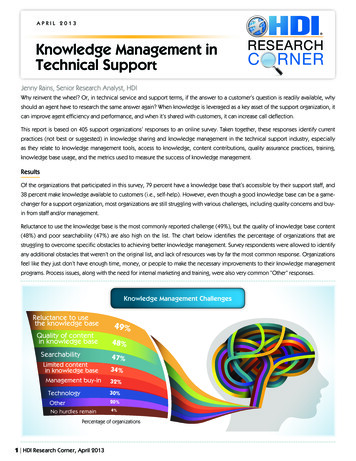
Transcription
a p ril 2 0 1 3Knowledge Management inTechnical SupportJenny Rains, Senior Research Analyst, HDIWhy reinvent the wheel? Or, in technical service and support terms, if the answer to a customer’s question is readily available, whyshould an agent have to research the same answer again? When knowledge is leveraged as a key asset of the support organization, itcan improve agent efficiency and performance, and when it’s shared with customers, it can increase call deflection.This report is based on 405 support organizations’ responses to an online survey. Taken together, these responses identify currentpractices (not best or suggested) in knowledge sharing and knowledge management in the technical support industry, especiallyas they relate to knowledge management tools, access to knowledge, content contributions, quality assurance practices, training,knowledge base usage, and the metrics used to measure the success of knowledge management.ResultsOf the organizations that participated in this survey, 79 percent have a knowledge base that’s accessible by their support staff, and38 percent make knowledge available to customers (i.e., self-help). However, even though a good knowledge base can be a gamechanger for a support organization, most organizations are still struggling with various challenges, including quality concerns and buyin from staff and/or management.Reluctance to use the knowledge base is the most commonly reported challenge (49%), but the quality of knowledge base content(48%) and poor searchability (47%) are also high on the list. The chart below identifies the percentage of organizations that arestruggling to overcome specific obstacles to achieving better knowledge management. Survey respondents were allowed to identifyany additional obstacles that weren’t on the original list, and lack of resources was by far the most common response. Organizationsfeel like they just don’t have enough time, money, or people to make the necessary improvements to their knowledge managementprograms. Process issues, along with the need for internal marketing and training, were also very common “Other” responses.Knowledge Management ChallengesReluctance to usethe knowledge baseQuality of contentin knowledge baseSearchabilityLimited contentin knowledge baseManagement buy-inTechnology49%48%47%34%32%30%Other20%No hurdles remain4%Percentage of organizations1 HDI Research Corner, April 2013
Knowledge QualityWhile almost half of the respondents identified content quality as one of their obstacles, only 57 percent are training their staff toenter content into the knowledge base. More organizations are formally training their staff to search the knowledge base (67%) thancontribute to it. The people most commonly tasked with contributing to the knowledge base are level 1 staff, but the majority tasklevel 2 staff, as well as other levels or departments, with contributing knowledge. Thirty-nine percent have a dedicated person or teamOther levels ordepartmentsLevel 2Level 1OtherKnowledge BaseContributorsDedicated knowledgeperson or teamtasked with contributing to the knowledge base.39%50%68%76%11%Percentage of organizationsMost organizations (71%) have a style guide for contributing content to the knowledge base, though 17 percent admit that mostcontributors don’t adhere to it. In 27 percent of organizations, contributions are not published unless they adhere to the style guide.Style Guide forContributed ContentWe have one,but no oneadheresto it.We haveone, andmost adhereto it.Contributionsare notpublishedunless theyadhere tothe styleguide.29%We donot haveone.3%We have one,but only someadhere to it.14%2726%%Percentage of organizations2 HDI Research Corner, April 2013
This brings us to the topic of monitoring. How closely are knowledge base articles being monitored? Sixty percent of organizationsreview every document that’s submitted, while some organizations (15%) only review documents submitted by specific contributors(e.g., new analysts). Others review a random sampling of documents (9%), and 16 percent of support organizations aren’t monitoringthe knowledge base at all.Many argue that although a knowledge article may not be perfect when it’s submitted, it should be searchable within the knowledgebase anyway; 30 percent of organizations make knowledge available immediately, before any review. One to two days is a slightlymore common practice; few let articles linger longer than that without making them available.Average Time Between Submission and Availability in the Knowledge EM6%SDAY0N1THAeontagePercionsizatanf orgMetricsTo benchmark and trend the success of knowledge management, organizations need to track metrics specific to the use of theknowledge base. Thirty-nine percent of organizations with a knowledge base aren’t currently tracking related metrics. Of thoseorganizations that are, the most common practices are to measure the number of knowledge articles created overall (45%) and per analyst(32%). The chart below shows the percentage of organizations measuring specific knowledge management metrics. On this surveyquestion, respondents were allowed to list any additional metrics their organizations use to measure knowledge management. The mostcommonly reported metrics related to usage, such as the number of searches, hits on an article, downloads, visits, comments, and edits.Number of knowledge articles createdNumber of knowledge articles created per t of tickets closed using knowledge26%Knowledge articles published to self-serviceKnowledge quality indexOther knowledge management metric3 HDI Research Corner, April 201318%12%7%Percentage of organizations45%
Call deflection (i.e., tickets resolved by end users/customers using knowledge retrieved via self-help) is one of the benefits of providingcustomers with access to knowledge. For those organizations that do, the median estimated call deflection is 12 percent. About 34percent of organizations that provide this type of self-help estimate a call deflection rate greater than 20 percent.For organizations with a knowledge base in place for support staff, knowing how many tickets were resolved using a knowledgearticle is one of the keys to measuring the usage and success of knowledge management. The median percentage of tickets resolvedby using a knowledge article is 40 percent, and about 39 percent of organizations report using their knowledge base for more thanhalf of the tickets resolved. This is an industry-wide result; organization results vary, along with the types of tickets they receive.This is something to keep in mind when setting goals. For example, if one-third of the tickets received by a support center are forpassword resets, support staff shouldn’t be expected to access the knowledge base for each of those tickets. In addition, thismetric should be analyzed alongside an organization’s KPIs, and it should be tracked over time to determine whether the resultsalign with the business’s goals.Knowledge Management ToolsFinally, organizations were asked about the knowledge management tool(s) they’re either currently using or planning to start using in thenext twelve months. Microsoft’s SharePoint is the leader in this space, with 31 percent of organizations currently using it, but the list ofsolution providers in this space is quite long. The chart below includes any tool selected by more than one percent of organizations.SharePoint by MicrosoftKnowledgeManagementTool Usage(Currently in useor planning to startusing in the nexttwelve months.)BMRemedy ITSM Suite by BMCRightAnswers Unified Knowledge Platformby RightAnswers13%FootPrints by Numara (BMC)Service Desk Manager by CAServiceNowPercentage of organizations31%5%Home-grown (developed in house)Confluence by AtlassianService Manager by HPCherwell Service Management by CherwellKnova by ApteanUnicenter by CA4%3%2%Inquira by InquiraUniversal Knowledge Suite (UKS) byKnowledge Powered SolutionsActive Agent by NextITInfra by VmWareParature by Parature4 HDI Research Corner, April 20131%
It’s clear from the results of this survey that organizations understand the value of knowledge management, even though they arestruggling to optimize the process and gain buy-in. In the pursuit of these objectives, organizations are using different methodologiesand strategies for their knowledge management initiatives, with varying degrees of success. Some organizations base their initiativeson the capabilities of their tools, while others follow knowledge engineering methodologies. But based on other HDI research,we know that a higher percentage of organizations are using ITIL to guide their service management processes. ITIL, however, doesn’tprovide the guidance necessary to adopt knowledge management in the support center; the Knowledge-Centered Support (KCS)methodology does.KCS is recognized as a set of best practices for knowledge management within service management. Practices like knowledge monitoring,adhering to quality criteria, capturing the proper metrics, and making everyone in the organization responsible for knowledge are someof the requirements of the KCS methodology that have not been broadly adopted by the industry. However, according to the 2012HDI Support Center Practices & Salary Report, 19 percent of organizations have adopted KCS, with an additional 15 percent planningto do so. As more organizations adopt best practices like KCS, HDI expects to see improvements in knowledge management reflectedin future research.Sponsored byFor all available HDI Research Corner reports, visit www.ThinkHDI.com/BePartOfTheCorner.Copyright 2013 UBM LLC. All rights reserved.5 HDI Research Corner, April 2013
practices (not best or suggested) in knowledge sharing and knowledge management in the technical support industry, especially as they relate to knowledge management tools, access to knowledge, content contributions, quality assurance practices, training, knowledge base usage, and the metrics used to measure the success of knowledge management.

